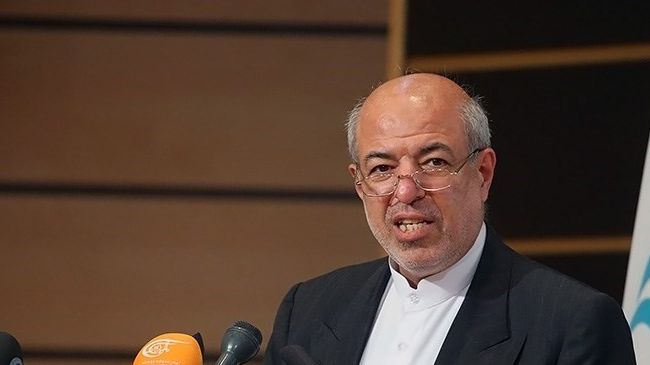
Energy Minister Hamid Chitchian continues to sound the death-knell for major dam-building in Iran after two-thirds of a century of such projects. Monday, the Mehr news agency said he had canceled a number of dam projects, but did not say how many or where they were located.
For more than a year, Chitchian has railed against Iran’s fascination with dams. But he has not announced any clear policy on dam construction.
On Monday, he said that studies dating back 15 years on which many current dam projects are based are no longer relevant, given the long drought and the high consumption of water. He said dam projects that forecast reservoirs holding 150 million cubic meters of water have ended up holding only 30 million or one-fifth what was forecast.
The drying up of many parts of Iran—especially the near disappearance of Lake Urumiyeh—has been blamed in many instances on unfettered dam construction, which has diverted water from lakes and wetland areas.
Dam construction began in earnest under the Shah in the 1950s, but took off after the Iran-Iraq war. Iran currently has 647 dams, of which 600 were built after the revolution. Mehr said 146 dams are currently under construction and 537 other dam projects are under study. It did not say how many dam projects Chitchian has canceled.
Chitchian began his campaign against dams in June 2014, saying, “Construction of new dams will not add to any water resources and will merely re-distribute the same resources, while some of the dams already constructed have not collected much water behind them.”
He said that in an interview with the Islamic Republic News Agency, but IRNA failed to pin him down on exactly what he meant, although it sounded like he was announcing an end to the huge dam-building era.
If dam construction were indeed severely curtailed, it would have a major economic impact. The end of such construction expenditures would save the regime much money. But the dam-building era saw Iran develop an entire industry devoted to dam construction. Ending that era could be devastating for many business firms, not to mention the careers of many engineers.
Iran is now in an era of water shortages that dams cannot cure. Chitchian said last year his focus would be on desalination of seawater and moving that water to parched areas of the country.
He said his Energy Ministry, which chiefly overseas water and electricity, was investing in a project to transfer desalinated Persian Gulf and Sea of Oman water to Sistan va Baluchestan and several central provinces to counter droughts, IRNA reported.
The Ahmadi-nejad Administration had adopted a plan to move desalinated Caspian water to the central provinces. “Since the salt density of the Caspian Sea would have increased highly after desalination of its water and that would threaten fish there, the Environmental Protection Agency opposed that plan,” he said in a meeting with clerics in Qom.
The energy minister added that therefore his ministry has proposed transferring Persian Gulf and Sea of Oman water to those provinces instead.
Chitchian said last summer that in recent years rainfall has decreased by as much 47 percent in 15 of Iran’s 31 provinces.
The energy minister said farmers in those areas have resorted to irrigation with well water to make up for the missing rain. “If those farmers will turn off their electrical pumps during the four high electricity usage hours of the day, their electricity during the remaining 20 hours will be provided free of charge,” he promised.
He did not speak directly of the problem of the falling water table as a result of farmers pumping out much more water than in the past. However, he said underground water resources across Iran have fallen 10 billion cubic meters to 120 billion cubic meters. He didn’t say how long ago the country had 130 billion cubic meters of underground water.
The energy minister rejected proposals made by some provincial governors general and Majlis deputies for more dam construction to trap more river water.
Chitchian said 92 percent of the country’s water is used by agriculture with a lot of that water wasted. In almost all countries, agriculture is the greatest consumer of water, although rarely as high as in Iran. Around Lake Urumiyeh, where dams have shut off the flow of water into the lake, a project being managed by the Japanese is trying to get farmers to shift to drip irrigation, where almost all water goes directly to plant roots and does not evaporate from the surface.
Water shortages are expected to remain a key resource problem in Iran, similar to other regions in the Middle East, and many fear that could cause regional instability if policy-makers do not develop long-term water management strategies, particularly for irrigation projects.
The water content of rivers and aquifers is limited in all countries by rainfall, but population is not. The population of Iran has more than doubled since the revolution, increasing the demand for water. And the revolution’s goal of self-sufficiency in food production has put great pressure on water resources.
Water availability is considered a severe constraint on socio-economic development and environmental protection when annual internal renewable water resources fall below 1,000 cubic meters per capita.
Iran’s per capita water resources were 2,025 cubic meters in 1990, but are forecast to fall to 816 cubic meters by 2025, according to the United Nations Development Program (UNDP).
Currently, a third of Iran’s population lives in drought-impacted areas. The shortage of local storage ponds prevents the practical use of much rainfall. Floods occur often.
